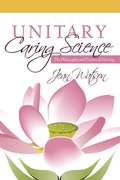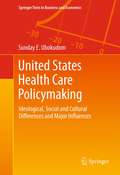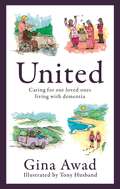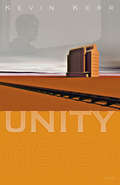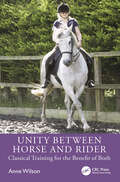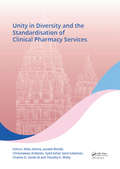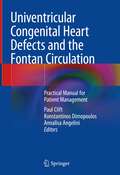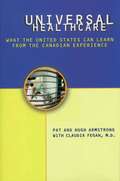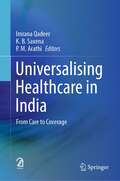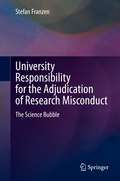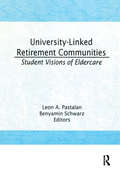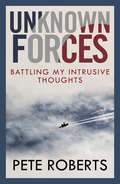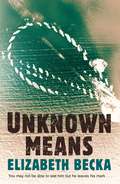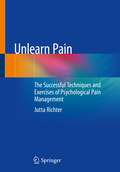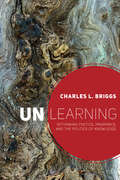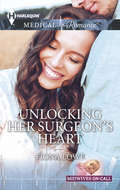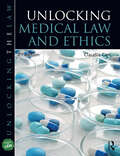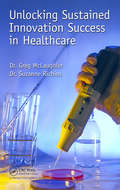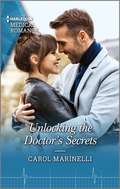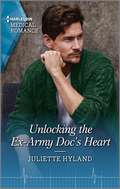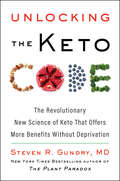- Table View
- List View
Unitary Caring Science: Philosophy and Praxis of Nursing
by Jean WatsonUnitary Caring Science: The Philosophy and Praxis of Nursing takes a profound look at conscious, intentional, reverential caring-healing as sacred practice/praxis and as a necessary turn for survival. Jean Watson posits Unitary Caring Science for the evolved Caritas-conscious practitioner and scholar. A detailed historical discussion of the evolution from Caring Science toward Unitary Caring Science reflects the maturing of the discipline, locating the nursing phenomena of wholeness within the unitary field paradigm. An exploration of praxis as informed moral practice results in an expanded development of the ten Caritas processes, resulting in a comprehensive value-guide to critical Caritas literacy and ontological Caritas praxis. Watson writes for the Caritas Conscious Nurse™ or the Caritas Conscious Scholar/Practitioner/Educator on the journey toward the deeper caring-healing dimensions of life. Unitary Caring Science offers a personal-professional path of authenticity, bringing universals of Love, Energy, Spirit, Infinity of Purpose, and Meaning back into nurses lives and their life’s work. Unitary Caring Science serves as a continuing, evolving message to the next generation of nurse scholars and healing-health practitioners committed to a praxis informed by mature disciplinary consciousness. Each book comes with a set of Caritas cards, and individual customers will also receive a secure link to select copyrighted teaching videos and meditations on www.watsoncaringscience.org.
United States Health Care Policymaking
by Sunday E. UbokudomHealth care is a very important component of the American economy. The United States Centers for Medicare and Medicaid Services (CMS) put the 2008 direct health care expenditures at about $2.34 trillion, or about 16.2 percent of the nation's gross domestic product (GDP), or an average of $7,681 spent for every man, woman, and child in the country. Health care cost increases have caused very serious problems that threaten to bankrupt the system, providers, employers, and the families that pay the costs that their health insurance plans do not cover. Additionally, cost increases have reduced access to health care services, adversely affected the quality of care, and resulted in avoidable illnesses, premature deaths, and in health disparities based on race, ethnicity, and income. Consequently, health care reform has continuously been on the public and governmental agendas. It is out of this environment that several reform plans, including the 1993 Health Security Act, and the 2010 Patient Protection and Affordable Care Act (PPACA), were launched. This book examines the ideological, social, cultural, economic, and several other factors that dictate the various measures and approaches employed to tackle the perceived problems. The book has an index, tables, charts and figures, lists of major terms, and review questions for each chapter. This book will appeal to students in Master of Health Administration (MHA), Master of Public Health (MPH), Master of Public Administration (MPA), Master of Science in Nursing (MSN), health certificate programs, and junior and senior level undergraduate students in political science, public administration, public health, and public policy. In addition to serving as a core text for health policy and administration classes, the book will serve as a supplementary text for graduate level courses.
United: Caring for our loved ones living with dementia
by Gina AwadA moving and beautifully illustrated book that captures the real life tales of people living with dementia, as told by their loved ones caring for them.This humorous, heartwarming and often heartbreaking collection will be relatable and supportive for anyone touched by dementia in their lives, and provides insight and information for anyone wanting to know more.The stories reflect on: the impact of receiving a diagnosis, the importance of person-centred care and social inclusion; the power of meaningful engagement, partnerships, peer support and much, much more.
United: Caring for our loved ones living with dementia
by Gina AwadA moving and beautifully illustrated book that captures the real life tales of people living with dementia, as told by their loved ones caring for them.This humorous, heartwarming and often heartbreaking collection will be relatable and supportive for anyone touched by dementia in their lives, and provides insight and information for anyone wanting to know more.The stories reflect on: the impact of receiving a diagnosis, the importance of person-centred care and social inclusion; the power of meaningful engagement, partnerships, peer support and much, much more.
Units, Symbols, and Abbreviations: A Guide for Authors and Editors in Medicine and Related Sciences, Sixth edition
by Denis Baron H.M. ClarkeNow in its sixth edition, this guide sets out international and standard practice and is an invaluable reference for medical and scientific editors and authors. Scholarly journals often quote this booklet as a guide in their instructions to authors.An invaluable reference for editors and authors. Includes fully updated sections on metrication and SI units, symbols and nomenclature, layout of references and proof correction.
Unity
by Kevin KerrIn the fall of 1918, a world ravaged by war was suddenly hit by a mysterious and deadly plague. As fear of the dreaded "Spanish" flu fills the town of Unity with paranoia, drastic measures are taken. But when the disease descends upon the town despite their precautions, the citizens begin to turn on each other, looking for a scapegoat.
Unity between Horse and Rider: Classical Training for the Benefit of Both
by Anne WilsonMany riders and horse owners are looking for a kinder, more ethical way of interacting with their horses, to fulfil the requirements of the modern Social Licence to Operate but also to enhance their relationship with their animal. In this book, author and expert rider Anne Wilson demonstrates that we need look no further than the teachings of the great classical riding masters, past and present.Classical teachings are often misunderstood today. This in-depth book on classical principles aims to rectify that, enlightening the reader on techniques which will enhance their own enjoyment as well as that of their horses. Wilson provides a wealth of ‘how-to’ information, via down-to-earth language and detailed imagery, which will enable readers to put the principles into effect. She throws light on hitherto much misunderstood aspects of horse training, showing that when these principles are employed correctly, the rider or trainer will experience an incomparable feeling of being at one with their horse. Perhaps most importantly, this book will help your horse enjoy ‘dancing’ with his or her rider, enhancing their physical and mental well-being, as well as their likely longevity.Unity between Horse and Rider: Classical Training for the Benefit of Both will be of great benefit to riders in any discipline who have basic knowledge and skills but wish to learn a more ethical, fulfilling way of training and riding. For riders, riding professionals, students and trainers, classical riding is the key to a happy life for horse and human alike.
Unity in Diversity and the Standardisation of Clinical Pharmacy Services: Proceedings of the 17th Asian Conference on Clinical Pharmacy (ACCP 2017), July 28-30, 2017, Yogyakarta, Indonesia
by Elida Zairina, Junaidi Khotib, Chrismawan Ardianto, Syed Azhar Syed Sulaiman, Charles D. Sands III and Timothy E. WeltyUnity in Diversity and the Standardisation of Clinical Pharmacy Services represents the proceedings of the 17th Asian Conference on Clinical Pharmacy (ACCP 2017), held 28—30 July 2017 in Yogyakarta, Indonesia. The primary aim of ACCP 2017 was to bring together experts from all fields of clinical pharmacy to facilitate the discussion and exchange of research ideas and results. The conference provided a forum for the dissemination of knowledge and exchange of experiences. As such, it brought together clinical pharmacy scholars, pharmacy practitioners, policy makers and stakeholders from all areas of pharmacy society and all regions of the world to share their research, knowledge, experiences, concepts, examples of good practice, and critical analysis with their international peers. This year also marks the celebration of 20 years of ACCP. Central themes of the conference and contributed papers were Clinical Pharmacy, Social and Administrative Pharmacy, Pharmacy Education, Pharmacoeconomics, Pharmacoepidemiology, Complementary and Alternative Medicine (CAM) and a number of related topics in the field of Pharmacy.
Univentricular Congenital Heart Defects and the Fontan Circulation: Practical Manual for Patient Management
by Annalisa Angelini Konstantinos Dimopoulos Paul CliftThis book provides a concise, practically applicable guide to the management of patients born with a univentricular heart defect. It describes the anatomy and epidemiology of the univentricular heart, while guidance is provided on how to manage both fetal and neonatal patients with this defect, as well as those in later childhood and adulthood. The utilization of the Fontan operation for patients with a univentricular heart is described in detail. Management of early and late Fontan failure is also discussed, and the pregnant patient is also described, enabling the reader to develop a deep understanding of how to manage these patients in their daily practice. Univentricular Congenital Heart Defects: Practical Manual for Patient Management comprehensively reviews the management of univentricular heart defects and the use of Fontan-type surgery. It is a valuable resource for the experienced practitioner seeking a manual on the latest available techniques and for trainees who want to develop a thorough understanding of how to manage patients with these congenital heart defects.
Universal Health Care 101: Lessons for the Eastern Caribbean and Beyond
by Evridiki TsountaA report from the International Monetary Fund.
Universal Health Care: What the United States Can Learn from the Canadian Experience
by Pat Armstrong Hugh Armstrong Claudia FeganThe Canadian health-care system, which guarantees medical care for the entire population without charge at the time it is provided, also allows doctors and patients more choice than the American system about whom to see and what medical procedures to provide. Describing the various mechanisms that make the Canadian system work, this book also highlights the problems of the current US system. In the process, the authors set out to demonstrate how a public, single-payer system can provide high-quality care to many more people at much less cost than the present market-based system.
Universalising Healthcare in India: From Care to Coverage
by K. B. Saxena Imrana Qadeer P. M. ArathiThis book provides a comprehensive overview of universal health coverage in India. It starts by setting the historical context and politics of the debates around universal health coverage (UHC) in India and proceeds to analyze the present crisis of public health in the country. The book examines the present policies on the pharmaceutical industry, missing links in universalizing health, and the importance of social determinants of health. It is divided into five sections, and some of the topics covered include the difference between comprehensive primary health care and universal health care, public health and medical care, health service, and health system. The chapters are contributed by scholars and practitioners based on historical, interdisciplinary, empirical, and policy research. The book is insightful to academics, public health administrators, policymakers, practitioners, and students interested in health care and organization, looking to transform theory into policy and practice.
University Responsibility for the Adjudication of Research Misconduct: The Science Bubble
by Stefan FranzenThis book offers a scientific whistleblower’s perspective on current implementation of federal research misconduct regulations. It provides a narrative of general interest that relates current cases of research ethics to philosophical, historical and sociological accounts of fraud in scientific research. The evidence presented suggests that the problems of falsification and fabrication remain as great as ever, but hidden because the current system puts universities in charge of investigations and permits them to use confidentiality regulations to hide the outcomes of investigations. The book documents the significant conflict of interest that arises because federal regulation gives universities the responsibility to conduct investigations of their own faculty with severely limited oversight. The book is intended for young research scientists or anyone who wishes to understand the challenges faced by scientists in the workplace today. The central thread in the book is an exclusive account of an experienced research scientist who was the first to expose the facts that led to the longest running research misconduct investigation in the history of the National Science Foundation.
University-Linked Retirement Communities: Student Visions of Eldercare (Journal Of Housing For The Elderly)
by Benyamin Schwarz Leon A PastalanUniversity-Linked Retirement Communities focuses on the special attributes of a retirement community designed as an integral part of a university. It discusses the theoretical and practical aspects of such a retirement community, which provides a rich and varied context for older people to be exposed to new ideas and learning opportunities for personal growth. The book centers on the premise that knowledge of basic principles of human behavior helps clarify understanding of the relationship between environment and behavior. Grounded in current research in the field of environment and aging, the book helps readers consider how the environment lends different aesthetic experiences and activity patterns to people of different backgrounds and capabilities. Some of the major environment and design issues chapters address are:person-environment fitprivacy personal spacewayfinding barrier-free designhealthcarepersonal growthsite developmentUniversity-Linked Retirement Communities was developed from a two-term course offered at the University of Michigan College of Architecture and Urban Planning that dealt with aging and the environment. The book is divided into two parts. Chapters in the first section discuss a variety of issues, including the meaning of “community,” a day in the life of an elderly person living in a retirement community, site evaluation for a theoretical retirement community, and reviews of different physical components for a retirement community. The second section contains four student presentations of designs for a retirement community and comments on the projects from a design jury.This book is a valuable source of information for a variety of readers. University-Linked Retirement Communities is of interest to potential users of eldercare services and their families; service providers; designers, architects, policymakers, and developers dealing with the elderly; and educators and students of architecture, environmental design, and other fields who are involved in housing and care options for senior adults.
Unknown Forces: Battling My Intrusive Thoughts (Inspirational Series)
by Pete Roberts“Surely only the deranged actively imagine the brutal maiming of those closest to them … ”Pete Roberts was a boy just like any other. Except for the fact that he kept thinking about murdering his family with household implements ...Terrified by his own thoughts, Pete joined the RAF in the hopes that he could escape his urges and apply himself to something structured. While he didn't entirely avoid his intrusive thoughts, he defied his dyslexia to flourish in a teaching role and vowed to continue helping others to learn their craft. It wasn't until much later on that Pete found the answer to his torment: he had OCD. Funny and insightful, Unknown Forces follows Pete through his tumultuous life, from fatherhood to the Falklands and everything in between.
Unknown Means
by Elizabeth Becka'The woman's body had been posed. She sat upright at her kitchen table. Mesh straps held her shoulders and waist to the high-backed wooden chair; the same straps had been used to strangle her. Raindrops hammered the windows, extra loud in the sudden quiet and as Evelyn leaned toward the body, she got close enough to catch the scent of fresh death.When forensic pathologist Evelyn James is called out to the penthouse of a beautiful Cleveland heiress, she discovers the young woman's body, violently strangled and left in a life-like pose, a priceless diamond necklace carefully arranged about her neck.Despite the most exclusive security system money can buy, there is no trace of the killer's deadly visit to the scene of the murder. It's as though the murderer is a ghost, capable of walking between walls, untraceable - and unstoppable. As the terrified inhabitants try to go about their daily lives, the killer stalks, undetected through the corridors. When another young woman from the building is brutally attacked, Evelyn knows she must unravel the mystery of the unseen killer, before it's too late.
Unlearn Pain: The Successful Techniques And Exercises Of Psychological Pain Management
by Jutta RichterThis book shows concrete techniques and exercises of psychological pain management, with which it is possible to reduce pain permanently. It is aimed at all pain patients who want to actively manage pain and at all therapists and doctors who want to support their patients in this. The more than 30 successful techniques and exercises, such as mindfulness exercises, relaxation techniques or hypnosis procedures, can be used alone at home without a doctor or therapist. Each exercise is explained step-by-step and simply, is scientifically recognized, has no side effects, and is effective regardless of the cause or location of the pain. The book also provides a wealth of background information on the development of pain and numerous practical tips. The 4th edition is completely updated.
Unlearning: Rethinking Poetics, Pandemics, and the Politics of Knowledge
by Charles L. BriggsA provocative theoretical synthesis by renowned folklorist and anthropologist Charles L. Briggs, Unlearning questions intellectual foundations and charts new paths forward. Briggs argues, through an expansive look back at his own influential works as well as critical readings of the field, that scholars can disrupt existing social and discourse theories across disciplines when they collaborate with theorists whose insights are not constrained by the bounds of scholarship. Eschewing narrow Eurocentric modes of explanation and research foci, Briggs brings together colonialism, health, media, and psychoanalysis to rethink classic work on poetics and performance that revolutionized linguistic anthropology, folkloristics, media studies, communication, and other fields. Beginning with a candid memoir that credits the mentors whose disconcerting insights prompted him to upend existing scholarly approaches, Briggs combines his childhood experiences in New Mexico with his work in graduate school, his ethnography in Venezuela working with Indigenous peoples, and his contemporary work—which is heavily weighted in medical folklore. Unlearning offers students, emerging scholars, and veteran researchers alike a guide for turning ethnographic objects into provocations for transforming time-worn theories and objects of analysis into sources of scholarly creativity, deep personal engagement, and efforts to confront unconscionable racial inequities. It will be of significant interest to folklorists, anthropologists, and social theorists and will stimulate conversations across these disciplines.
Unlocking Her Surgeon's Heart
by Fiona LoweTaming her brooding surgeon Noah Jackson just wants to be a surgeon, and he's a GP placement away from fulfilling his dreams. Being in Turraburra, even temporarily, is way out of his comfort zone-and he doesn't need (admittedly gorgeous) midwife Lilia Cartwright lecturing him about his bedside manner! But Noah discovers that Lilia's feistiness belies the most compassionate woman on earth-and if there is one person who can reach into this delicious but brooding doc's locked-away heart, it's Lilia. If she succeeds, can he also heal hers?
Unlocking Medical Law and Ethics 2e (Unlocking the Law)
by Claudia CarrUnlocking Medical Law and Ethics will help you grasp the main concepts of Medical Law with ease. Containing accessible explanations in clear and precise terms that are easy to understand, it provides an excellent foundation for learning and revising. The information is clearly presented in a logical structure and the following features support learning helping you to advance with confidence: Clear learning outcomes at the beginning of each chapter set out the skills and knowledge you will need to get to grips with the subject Key Learning Points throughout each chapter allow you to progressively build and consolidate your understanding End-of-chapter summaries provide a useful check-list for each topic Cases and judgments are highlighted to help you find them and add them to your notes quickly Frequent activities and self-test questions are included so you can put your knowledge into practice Sample essay questions with annotated answers prepare you for assessment Glossary of legal terms clarifies important definitions This second edition has been updated to include discussion of recent changes and developments within the module, such as updated case law, including: Birmingham Children’s NHS Trust v B 2014 EWHC 531; NHS Foundation Trust v A 2014 EWHC 920; A NHS Trust v DE 2013 EWHC 2562; Re P-M (Parental Order: Payments to Surrogacy Agency) 2013 EWHC 2328; R v Catt (Sarah Louise) 2013 EWCA 1187 and Doogan v Greater Glasgow and Clyde Health Board and others 2013 CSIH 36. The books in the Unlocking the Law Series get straight to the point and offer clear and concise coverage of the law, broken-down into bite-size sections with regular recaps to boost your confidence. They provide complete coverage of both core and popular optional law modules, presented in an innovative, visual format and are supported by a website which offers students a host of additional practice opportunities. Series editors: Jacqueline Martin LLM has over ten years’ experience as a practising barrister and has taught law at all levels. Chris Turner LLM is Senior Lecturer in Law at Wolverhampton University and has taught law at all levels.
Unlocking Sustainable Wellbeing in the Digital Age: New Avenues for Research and Practice (Human Well-Being Research and Policy Making)
by Melinde Coetzee Annelize Van Niekerk Nisha HarryThis volume includes global and interdisciplinary reflections for innovative solutions to facilitate wellbeing in the digital age, at individual, team and organisational levels. It provides new perspectives, strategies, theories and practices through analyses of multidisciplinary wellbeing research in different contexts influenced by the unprecedented era of technological advancement. It features insights into sustaining human-centric wellbeing across four streams of thought: Gauging psychosocial wellbeing risks in the age of digital transformation Balancing the technostress epidemic Overcoming technophobia: building tech confidence and competence Nurturing a culture of human-centric digital wellbeing This volume includes empirical evidence and cases across sectors and provides scholars and practitioners with useful frameworks and resources to unlock human and workplace wellbeing.
Unlocking Sustained Innovation Success in Healthcare
by Gregory C. McLaughlin Suzanne RichinsOutlining the critical need to apply innovation to reduce costs and improve efficiency in the healthcare industry, Unlocking Sustained Innovation Success in Healthcare explains why innovation management is a must for all healthcare organizations. It describes how innovation, when implemented as a strategy, can yield sustainable success. This book i
Unlocking the Doctor's Secrets
by Carol MarinelliA secret to break them……or make them?Paramedic Lina Edwards feels instant sparks with deliciously brooding consultant Garth Hughes—only, she&’s learned not to trust her instincts. Yet Garth makes her feel seen in a way she&’s never been before. The sadness in his eyes shows he has secrets, but when Lina discovers that, shockingly, she&’s bound up in his past, she must decide: Is their passionate connection too good to be true, or too good to let go? &“I always adore Carol's writing- her stories always enthrall and entertain me. This one is really special…. Carol writes so beautifully and this story is so tender and emotional. I heartily recommend this one.&”-Goodreads on The Nurse&’s Reunion Wish &“I really get sucked into this author's medical romances! She has a unique writing style that can be almost breathless at times.&”-Goodreads on The Midwife's One-Night Fling
Unlocking the Ex-Army Doc's Heart
by Juliette HylandIt will take someone special……to thaw her frozen heart!The Arctic Circle’s remote tranquility made it the perfect place for ex-army doc and former child star Annie Masters to open her clinic. But her cherished anonymity is ruined when celebrity surgeon Rafe Bradstone arrives in town! Seeing that she uses her work as a safe haven, dynamic Rafe seems determined to show her what she’s missing out on. And it’s working… She’s beginning to imagine a future—with him!
Unlocking the Keto Code: The Revolutionary New Science of Keto That Offers More Benefits Without Deprivation (The Plant Paradox #7)
by Dr. Steven R Gundry, MDFrom the author of the New York Times bestselling Plant Paradox series comes this revolutionary take on the keto diet that debunks common myths and shows readers how to reap the rewards of keto with less restrictionLike many doctors and nutrition experts, bestselling author Dr. Steven Gundry has long endorsed the ketogenic diet—a style of eating that heavily restricts carbohydrate intake to make the body burn fat for fuel. Because ketosis offers a variety of health benefits, including weight loss, reduced risk of illness, and enhanced energy, Dr. Gundry believed his patients’ efforts to adhere to the challenging regimen was worthwhile. That is, until his research uncovered a shocking truth: We’ve gotten keto all wrong.In Unlocking the Keto Code, Dr. Gundry reveals the biological mechanism that makes keto diets so successful: a cellular process known as “mitochondrial uncoupling.” As it turns out, ketones are not the magical fuel source they’ve been made out to be; in fact, the body cannot run on ketones and fats alone. Over the long term, a very low carb-diet can lead to muscle wasting and poor cognitive health. Luckily, you don’t have to restrict all carbs to reap the benefits of ketosis; you simply have to have enough ketones and other plant compounds called polyphenols present in your body to “unlock” the process of mitochondrial uncoupling. In this insightful, empowering, eminently practical book. Dr. Gundry explains the many ways readers can ignite this process, from feasting on plant-based foods (carbs that are typically off-limits on a keto diet!) to enjoying ketone generating foods such as goat and sheep milk products, to implementing a timed eating schedule. You will even discover the real reason how superfoods, even apple cider vinegar, work their magic; and its not what they you think!Grounded in cutting-edge science, this is the book for all the people who have tried and failed on a keto diet; for vegetarians and vegans who want to go keto; and for anyone who wants to lose weight and enjoy better health while eating a wide variety of foods. With food lists, hacks, and all-new recipes, Unlocking the Keto Code makes going keto easy and enjoyable for the first time.
